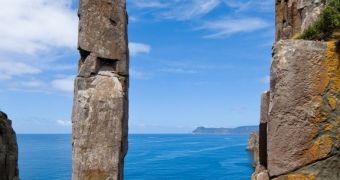One of the world's most amazing natural rock columns is found in Cape Hauy, Australia, and it attracts hundreds of adrenaline junkies willing to risk their lives just to make it to the top. The gigantic rock stands tall 210 feet (64 meters) above the ocean and it is every thrill-seeker's dream.
The vertical column of rock, called the Totem Pole, is a natural formation also known as a sea stack, formed by erosion in the sea or near coasts. The amazing landmark from Cape Hauy, Tasmania, Australia has the perfect conditions for climbers, but tight-rope walking was considered a bit too risky for this particular place.
“I have always found the climbing to be really hard as well as kind of scary and intimidating, every time it's been deeply satisfying. When I noticed climbers were also tight-rope walking across the top I was impressed,” photographer Simon Carter told Daily Mail.
Climbing the Totem Pole is both physically and mentally challenging, but the highwire cross is even more terrifying. The first time Simon saw the unique landscape, he was fascinated and immediately decided to photograph it, so he returned over and over again for the adrenaline kick rock climbing offers.
After years of climbing, the photographer noticed adrenaline junkies tight-rope walking and was completely mesmerized. “Not simply at the technical skills at what they were doing, and the faith they had in their safety setup, but by their ability to totally concentrate on what they were doing in the wind and 60-meters above the waves smashing into the base of the cliff below,” Simon said, according to Daily Mail.
For the photographer, these kinds of extreme activities are the perfect way to connect to nature, after being used to live in a society that can turn us into some very urban creatures. The Totem Pole adventure is a rush, as it can completely change one's perspective when they find themselves 210 feet above the ocean, on a vertical column of rock.

 14 DAY TRIAL //
14 DAY TRIAL //